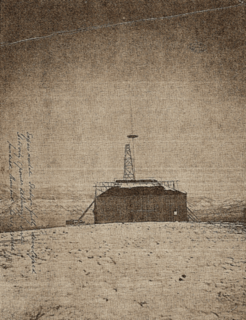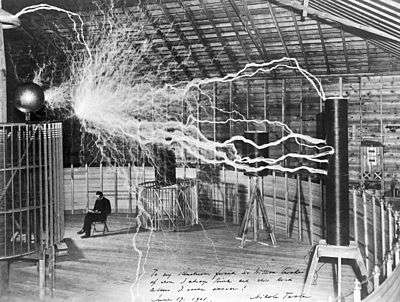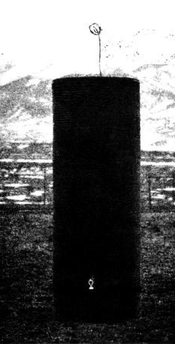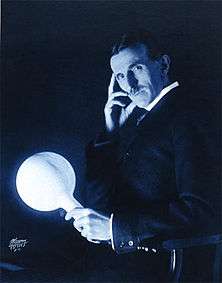Tesla Experimental Station
Coordinates: 38°50′17.628″N 104°46′55.96″W / 38.83823000°N 104.7822111°W



The Tesla Experimental Station[3] was a Colorado Springs laboratory built in 1899 by inventor Nikola Tesla and used that year for his study of the use of high-voltage, high-frequency electricity in wireless power transmission.
Location
The Experimental Station was located on empty land on the highest local point (Knob Hill) between the 1876 Colorado School for the Deaf and Blind and the Union Printers Home,[4] where Tesla conducted the research described in the Colorado Springs Notes, 1899-1900. A few papers of the times listed Tesla's lab as about 200 feet East of the Deaf and Blind School and 200 feet North of Pikes Peak Ave. This put it on top of the hill at E. Kiowa St. and N. Foote Ave (facing West); as documented by Pikes Peak Library District.[5]
Description
At Colorado Springs, in May 1899, Tesla, several of his assistants, and a local contractor commenced the construction of Tesla's laboratory shortly after arriving in Colorado Springs, Colorado, a high altitude location where he would have more room than in his downtown New York City laboratory for his high-voltage, high-frequency experiments. Tesla moved there to study the conductive nature of low pressure air,[6][7][8] part of his research into wireless transmission of electrical power. The lab possessed the largest Tesla coil ever built, 49.25 feet (15 m) in diameter,[9] which was a preliminary version of the magnifying transmitter planned for installation in the Wardenclyffe Tower. Upon his arrival, he told reporters that he planned to conduct wireless telegraphy experiments, transmitting signals from Pikes Peak to Paris.[10]
He produced artificial lightning, with discharges consisting of millions of volts and up to 135 feet (41 m) long.[11] Thunder from the released energy was heard 15 miles (24 km) away in Cripple Creek, Colorado. People walking along the street observed sparks jumping between their feet and the ground. Sparks sprang from water line taps when touched. Light bulbs within 100 feet (30 m) of the lab glowed even when turned off. Horses in a livery stable bolted from their stalls after receiving shocks through their metal shoes. Butterflies were electrified, swirling in circles with blue halos of St. Elmo's fire around their wings.[12]
While experimenting, Tesla inadvertently faulted a power station generator, causing a power outage. In August 1917, Tesla explained what had happened in The Electrical Experimenter: "As an example of what has been done with several hundred kilowatts of high frequency energy liberated, it was found that the dynamos in a power house 6 miles (10 km) away were repeatedly burned out, due to the powerful high frequency currents set up in them, and which caused heavy sparks to jump through the windings and destroy the insulation!"[13]
During his time at his laboratory Tesla observed unusual signals from his receiver which he concluded may be communications from another planet. He mentioned them in a letter to reporter Julian Hawthorne at the Philadelphia North American on 8 December 1899[14] and in a December 1900 letter about possible discoveries in the new century to the Red Cross Society where he referred to messages "from another world" that read "1 ... 2 ... 3 ...".[15][16] Reporters treated it as a sensational story and jumped to the conclusion Tesla was hearing signals from Mars.[15] He expanded on the signals he heard in a 9 February 1901 Collier's Weekly article "Talking With Planets" where he said it had not been immediately apparent to him that he was hearing "intelligently controlled signals" and that the signals could come from Mars, Venus, or other planets.[16] It has been hypothesized that he may have intercepted Marconi's European experiments in July 1899—Marconi may have transmitted the letter S (dot/dot/dot) in a naval demonstration, the same three impulses that Tesla hinted at hearing in Colorado[16]—or signals from another experimenter in wireless transmission.[17]
On 7 January 1900 Tesla made his final entry in his journal while in Colorado Springs.[18] In 1900 Tesla was granted patents for a "system of transmitting electrical energy" and "an electrical transmitter." When Guglielmo Marconi made his famous first-ever transatlantic radio transmission in 1901, Tesla quipped that it was done with 17 Tesla patents, though there is little to support this claim.[19]
In 1904, Tesla was sued for unpaid debts in Colorado Springs.[20] His lab was torn down in 1904, and its contents were sold two years later at auction at the court house to satisfy his debts.[21][22]
References
- 1 2 3 Carlson 2013, p. 290–301.
- 1 2 Tesla, Nikola (2002). Nikola Tesla on His Work with Alternating Currents and Their Application to Wireless Telegraphy, Telephony, and Transmission of Power: An Extended Interview. 21st Century Books. pp. 96–97. ISBN 978-1-893817-01-2.
- ↑ The Giles City Directory of Colorado Springs and Manitou (PDF) (almanac). The Giles Directory Company. May 1903. Retrieved 2013-11-02.
Cahill F A watchman Tesla Station bds [resides] 1104 E Platte ave ... Tesla Experimental Station, 1 mile east of P O [main post office] via Pike's Peak ave
- ↑ Carlson, W.B. (2013). Tesla: Inventor of the Electrical Age. Princeton University Press. p. 266. ISBN 9781400846559. Retrieved 2015-02-26.
- ↑ Tracing Tesla: the search for his lost laboratory (DVD). 2011.
- ↑ Robert Uth, Tesla, Master of Lightning, Barnes & Noble Publishing - 1999, page 92
- ↑ PBS, Tesla - Life and Legacy - Colorado Springs
- ↑ W. Bernard Carlson, Tesla: Inventor of the Electrical Age, Princeton University Press - 2013, page 264
- ↑ Hull, Richard, The Tesla Coil Builder's Guide to The Colorado Springs Notes of Nikola Tesla, 21st Century Books, 1994, p. 89.
- ↑ Cheney, Margaret (2001). Tesla: Man Out of Time. Simon and Schuster. p. 173. ISBN 978-0-7432-1536-7.
- ↑ Gillispie, Charles Coulston, "Dictionary of Scientific Biography;" Tesla, Nikola. Charles Scribner's Sons, New York.
- ↑ Childress 1993
- ↑ SECOR, H. WINFIELD (August 1917). "TESLA'S VIEWS ON ELECTRICITY AND THE WAR". The Electrical Experimenter. Retrieved 9 September 2012.
- ↑ Daniel Blair Stewart (1999). Tesla: The Modern Sorcerer, Frog Book. p. 372
- 1 2 Carlson 2013, p. 315.
- 1 2 3 Seifer 1998, pp. 220–223.
- ↑ Seifer, Marc. "Nikola Tesla: The Lost Wizard". ExtraOrdinary Technology (Volume 4, Issue 1; Jan/Feb/March 2006). Retrieved 14 July 2012.
- ↑ Cheney, Margaret; Uth, Robert (1999). Tesla: Master of Lightning. Barnes & Noble. p. 95. ISBN 978-0-7607-5568-6.
- ↑ "Nikola Tesla: The Guy Who DIDN'T "Invent Radio"". earlyradiohistory.us.
- ↑ "Nikola Tesla is sued". Colorado Springs Gazette. April 6, 1904.
- ↑ "Nikola Tesla in Colorado Springs". The Denver Eye. Archived from the original on 25 September 2012. Retrieved 17 June 2014.
- ↑ "Tesla Plant at Auction". Walla Walla, WA. Evening Statesman. 22 March 1906. Retrieved 17 June 2014.

